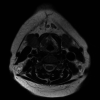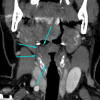Solitary extramedullary plasmacytoma of the larynx: a rare cause of dysphonia
- PMID: 32963040
- PMCID: PMC7509959
- DOI: 10.1136/bcr-2020-234478
Solitary extramedullary plasmacytoma of the larynx: a rare cause of dysphonia
Abstract
Solitary extramedullary plasmacytoma (SEP) of the larynx is a rare haematological malignancy and an infrequent cause of persisting dysphonia. We present the case of a 54-year-old woman with a long-standing history of dysphonia. While clinical examination showed a rather inconspicuous prominent right vestibular fold, an MRI revealed a laryngeal mass with erosion of the thyroid cartilage. A biopsy taken during rigid endoscopy demonstrated plasma cell infiltration with light chain restriction amidst amyloid deposits. After exclusion of systemic involvement, the diagnosis of an SEP of the larynx with secondary amyloidosis was made. The patient received primary radiation therapy. Another biopsy taken 3 months after the end of therapy did not show any signs of ongoing neoplastic plasma cell disease. The patient was therefore considered to be in remission. She is currently receiving regular follow-up and has not shown signs of persistent or progressive disease for the past 18 months.
Keywords: ear, nose and throat/otolaryngology; haematology (incl blood transfusion); radiotherapy.
© BMJ Publishing Group Limited 2020. No commercial re-use. See rights and permissions. Published by BMJ.
Conflict of interest statement
Competing interests: None declared.
Figures







References
Publication types
MeSH terms
LinkOut - more resources
Full Text Sources
Medical
Miscellaneous
